MOALA
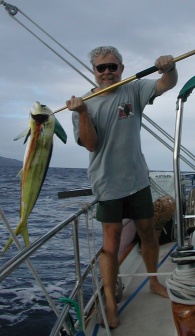
Mahi-mahi
We tossed out a fishing line as soon as we cleared the pass leaving Totoya, and we had a nice mahi-mahi within a few minutes. We put away our fishing gear and had a very nice sail back across the international dateline again to Moala. We arrived mid-day, and we needed the sun overhead to negotiate a dicey little pass. We chose to go deep in to the lagoon to seek out the most weather protection, and we anchored in 48′ mud. S/V Learjet came in about an hour later.
Moala is a relatively large volcanic island comprised of 24 square miles of land. It is rugged and heavily forested. Only one small village – Keteira – and a few isolated houses are visible from the central lagoon; however, the larger village of Naroi is on the north shore and not visible from within.
Soon after our arrival, Jone came out in his boat to welcome us. Jone is the spokesman for the chief of Keteira, and he took Bud and Glenn ashore to make sevusevu. While ashore, Bud and Glenn also met Jone’s wife – Talica – and their four children. They have a fifth child – a 16 year old daughter – but she lives and attends school in Suva. This family befriended us and would turn our Moala visit in to a special time for us.
The part of the island we visited has been very isolated. They have not had a cruising boat visit in 12 years, nor have they had any other visitors. We are the first caucasians the children have seen. Given their limited contact with the outside world, we were pleasantly surprised that many villagers spoke some English. Jone speaks excellent English (he lived in Suva for a few years), and Talica speaks well enough to communicate effectively.
We told Jone that we would like to dive the outer reef, and he offered to go along in the dinghy to guide us. We took two dinghies and went back to the pass through which we entered. Glenn dove with us, and we found it better than Totoya, but still disappointing. There are dramatic drop-offs and remnants of abundant hard corals, but the coral is in rough condition. When we surfaced, Jone told us that he had never seen anyone dive with tanks before. He was surprised that we could stay down so long. Glenn and Bud did two more dives on different areas of the reef and found it similarly rough.
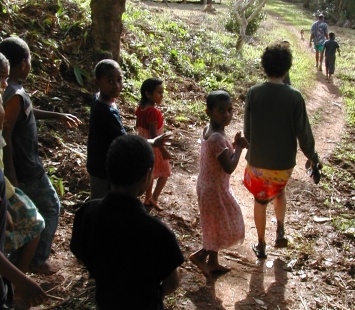
Very curious children
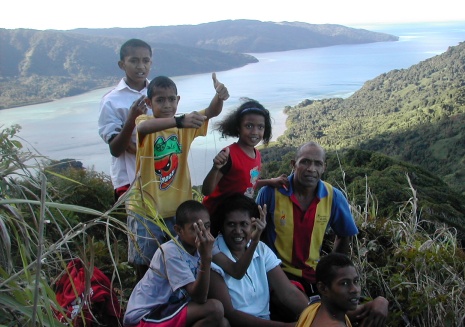
Jone & family atop Mount Mataravua
Jone also generously brought us lots of fruits and veges. At times we had more bananas than we could eat. He also shared foods from his other trees and garden.
Glenn expressed an interest in going for a hike, and Jone offered to be our guide. When we think of a ‘hike’, we think of moving on a relatively horizontal plane. However, our adventure was more of a ‘climb’ – a more vertical plane. We thought we were just hiking over the hill to the next village – Nasoki – where Talica is from. However, we ended up climbing Mount Mataravua.
Local lore says that those whom climb the mountain will get ‘the power’, but we really wished we could have gotten that power at the bottom of the mountain. It was a very rugged 1,255 foot climb without any trail. Jone himself had not been up there in ten years, and he had never taken visitors there before. This was also the first time his entire family climbed, and we later learned that few islanders have made the climb. It is rugged!
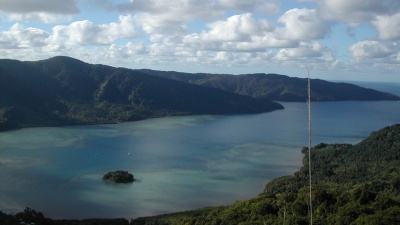
View of the anchorage from on top
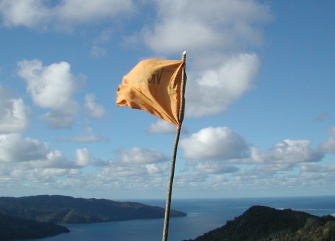
Our flag
But we made it to the top, and we planted a flag with our names on it. The flag reminded us of Neil Armstrong making it to the moon, and we felt as though the effort required by our journey was probably somewhat comparable to his. And the view from the top was breathtaking. Neither of us would have gone if we had known what we were in for, but when we stood up there 1,255 feet above the reefs, it seemed almost worth the effort. Then we had to get down.
We went down the opposite side of the mountain in to the village of Nasoki. We felt like real oddities there – our skin was white, we wore shoes, we carried cameras – but we felt most welcome. We felt welcome wherever we went on Moala.
Unfortunately, we didn’t go many places on Moala because the weather turned bad, and we had a lot of wind and rain. We did get out and fish a few times, and we did ok. We caught a walu which we gave to Jone and his family, and we caught a small trevally which we ate.
Two local children were writing their exams at the local school, and Jone asked if we would come take a few pictures for them. They also put on a tea for us. We took lots of pictures, then we sat down to drink some yanqona.
After a few bowls, the local men started playing their guitars and singing. Their singing was wonderful. We would have stayed much longer, but we were facing a falling tide and had to get our dinghy out while we still could.
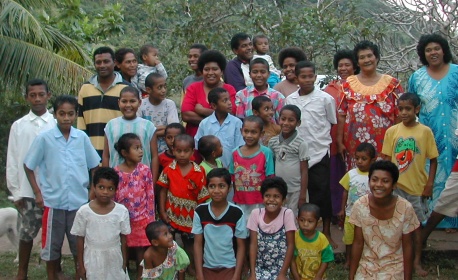
Nasoki villagers

Drinking yaqona & playing music
One of the men with whom we were drinking yanqona asked Bud if he could look at his outboard engine that was not running. Bud agreed and went back the following day. Bud and Jone fixed it with parts they scavenged from a ballpoint pen, and Bud made a new friend. Experiences like this are so common in the islands, and they are what keep us looking forward to the next island.
After having been on Moala for a week, we had a break in the weather. S/V Learjet seized the opportunity and headed north. We enjoyed cruising with them, and we missed their company almost immediately. But we have different agendas, and it was time for each of us to look forward in our chosen direction.
The weather remained nice the day after S/V Learjet left, so we went fishing. As we were heading out, we saw a power boat heading our way. We waved, but they did not wave back. We continued heading out, but we noticed that they went directly toward Passage then tied up to her stern. We turned around and went back.
There were three unfriendly men in the boat. One verbally identified them as police (police out here?!). We invited them aboard, but the only one with a voice declined. He wanted to know if we had permission to be there, and we said that we did. We offered paperwork from the Lau Provincial Council granting that permission, but that was not good enough for the voice, and he instructed us to come to the police post in Naroi the following day. We explained that we were trying to leave within a day or two, but his attitude did not soften. Off they went. We went off and caught a fish.
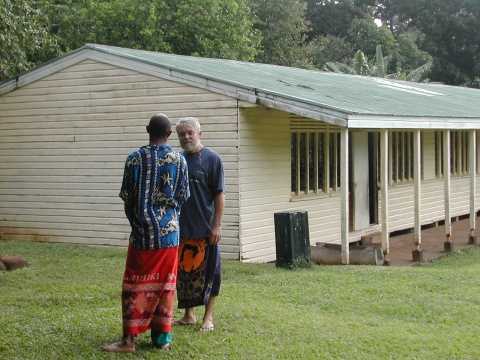
Bud & Jone at the school
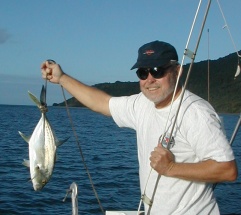
Trevally
We later went ashore and told Jone of our experience, and he offered to go to Naroi with Bud the following day. It was a long, wet, rough dinghy ride, and when they arrived, there was nobody at the police post. It was a long, wet, rough dinghy ride back.
We gave Jone two copies of our permission documents, and he said he would clear it with Peter, ‘the voice’. Apparently our documents said that we should check in at Naroi; however, they were written in Fijian, and we did not know. It is difficult to play by the rules when you do not know them.
The weather remained good, and we have learned that weather windows can be infrequent, so we knew it was time to leave. We said goodbye to Jone, Talica, and family with sadness. We will remember them and our time with them on this lovely island.